Building a Chatbot for Finding Podcasts
Building a Chatbot for Finding Podcasts
When writing for Conversational UI: ✂️ ✂️ ✂️


People listen to podcasts because it’s something they can do while engaging in a “boring” secondary activity like chores, walking the dog, or commuting to work. But podcasts also inspire and engage us.
For this experiment, I wanted to try building a chatbot that helps people discover podcasts. I assumed that people would choose to listen to podcasts because whatever they are interested in, there’s a podcast out there for them. They just need help figuring out what those podcasts are, and when to listen.
“Radiolab was the program that first introduced me to podcasts. That’s when I realized that audio can be interesting, and that it’s possible to be engaged with sound for a whole hour.” Quote from interview participant
Storytelling through a podcast is intimate and powerful. Stories evoke emotion, they bring us together, and they let us imagine different futures for ourselves. Could a Podcast Finder bot help serve up the right content at the right time for when you’re in the mood to listen to a podcast that will make you laugh (or cry), or feel connected to other people?
“When I moved to LA, I was lonely, I wanted to fill my head with other people’s thoughts. It started to become a habit, and I started learning, I wanted to expand my views. Listening to others people’s stories was a great way to build empathy and not feel so alone.” Quote from interview participant
The problem
Do Podcasts Have a Discoverability Problem?
Podcast themselves, social media and word of mouth are the primary drivers of listeners to podcasts. For recent NPR podcast launches, 6% to 20% of the listeners heard about a new podcast via social media. Compared with over 50% who first heard about it on another podcast (NPR Digital Day 2017)
Why is this an obstacle to discoverability? In the early days of television, only people with TV sets could recommend a show, and with podcasting, the problem is similar. If podcasts are only visible and discoverable inside the podcast apps, the only people who will find them are those who already listen.
When people say that “podcasts just aren’t for them” or that there aren’t topics that they are interested in — should we take their word for it or should we try to introduce them to what podcasts are differently?

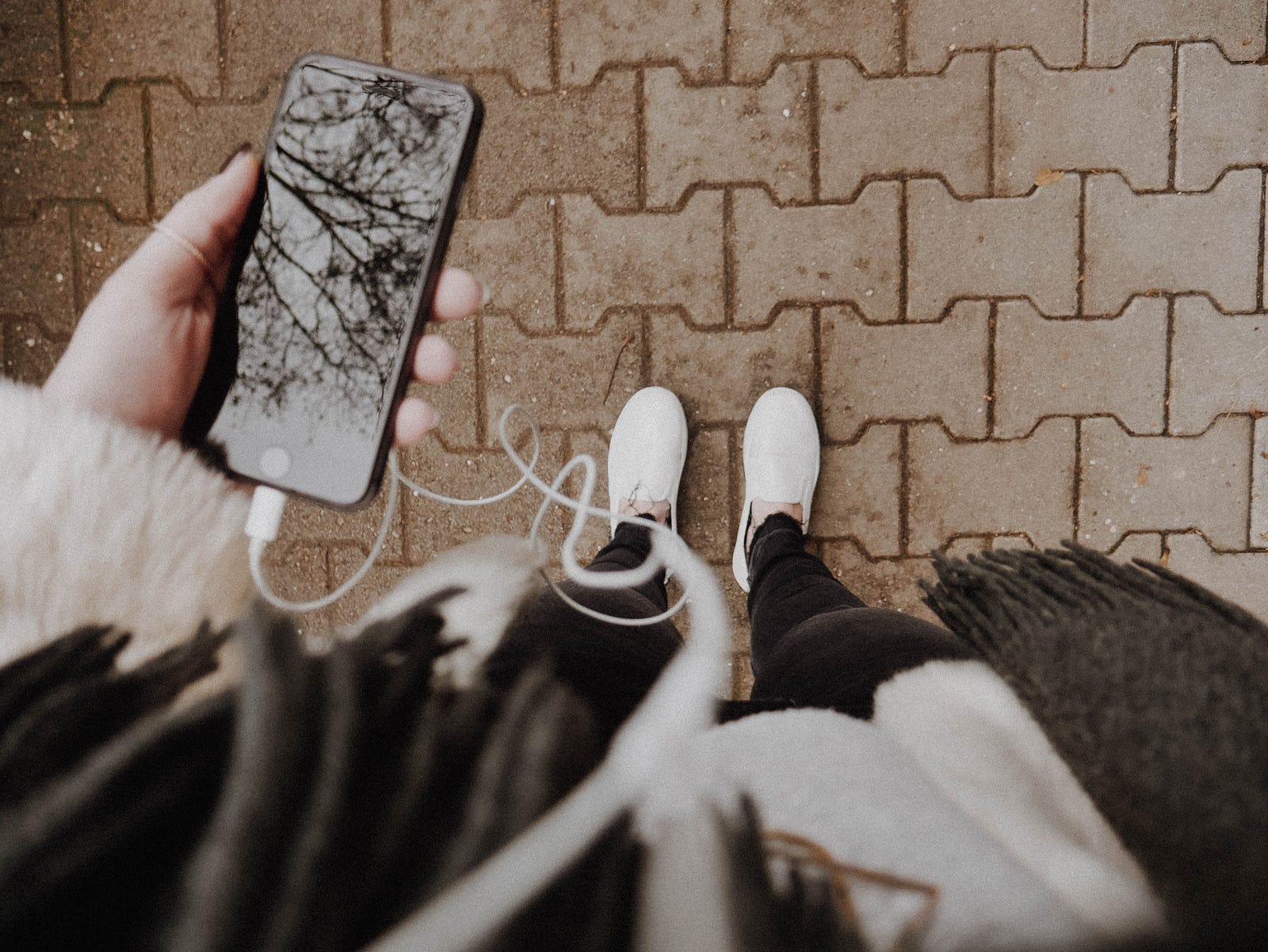
The Solution
Let’s make finding and discovering podcasts a conversation since the conversation is integral to podcasts.
Scope and Focus
The goal of this case study was to create a conversational UI experience on Google Assistant with a Podcast Finder bot. In theory, the bot would query an API from Listen Notes which indexes id3 tags. These tags are the metadata associated with the audio file which includes title, description, producer, and any other tags the creator adds to the file.
The chatbot would also utilize Google Assistant’s integrated podcast player, and use Google’s location services and calendar to send reminders to the user when they want to listen to a podcast later, like in the gym or on the way to work.
In reality, this is only a prototype, but the premise is possible.
Interviews and survey
I surveyed over 120 people with a six-question screener with three multiple choice questions and three open-ended questions. Some findings from the survey were:
- 50% of people use chatbots or voice assistants 3–7 times a week
- The most popular voice assistant is Siri (65%) followed by Alexa (45%) and Google Assistant/Home (32%)
- 80% of people access the assistant through their phone, and 35% through a smart speaker
- People self-reported that they mostly use the assistant to play music, ask about the weather, driving directions, or simple facts like a celebrity’s birthday
For the interviews, I sought out people who were already very passionate about podcast listening. I found some on podcasts groups on Facebook and others through UX writer networks and survey respondents. I wanted people who already knew a lot about podcasts because if I could design a conversation that would be useful for them, I could create other paths for the new and uncertain listener.
Existing Habits
- People listen to podcasts because it’s something they can do while engaging in another activity like chores, walking the dog, or commuting.
- People listen to podcasts to learn and to be inspired and as a way to make time spent doing something “boring” like commuting seems faster.
- Lifestyle has an impact on the amount of available time for listening. A single person living alone or with roommates is more likely to listen while getting ready in the morning or whenever they feel like it. People with children carve out time for podcast listening.
Unmet Needs
- It’s hard to determine the quality of a podcast since there are so many out there. People mostly rely on recommendations from other podcasts or trusted friends when picking something new to listen to.
- Most people get their recommendations from trusted sources like brands they follow on Instagram, podcasts they already listen to, and the articles they read. It’s a very closed loop system where you have to be in it to be part of it.
- Time-commitment is high when starting a new podcast, having trailers or bite-sized content would improve the ability to make a good choice.
Pain Points
- Category and genre search on podcast apps aren’t that informative, they don’t play trailers and don’t display reviews.
Based on the interview findings above, I created the job story for Podcast Finder.
Job Story
When I am doing chores or commuting to workI want to find a way to engage my mindSo I can learn or be inspired by others

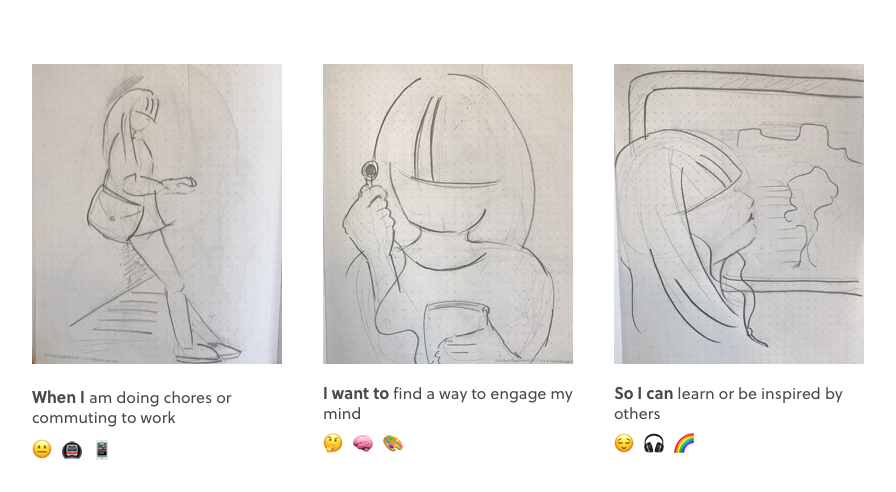
Sketching out Ideas
I figured out the best place to start thinking about the conversation for the Podcast Finder bot, was to look at how people already talked about podcasts. How do people ask for a recommendation in a Facebook group? What about on Reddit? How do people usually answer those questions, and what does a helpful answer look like?

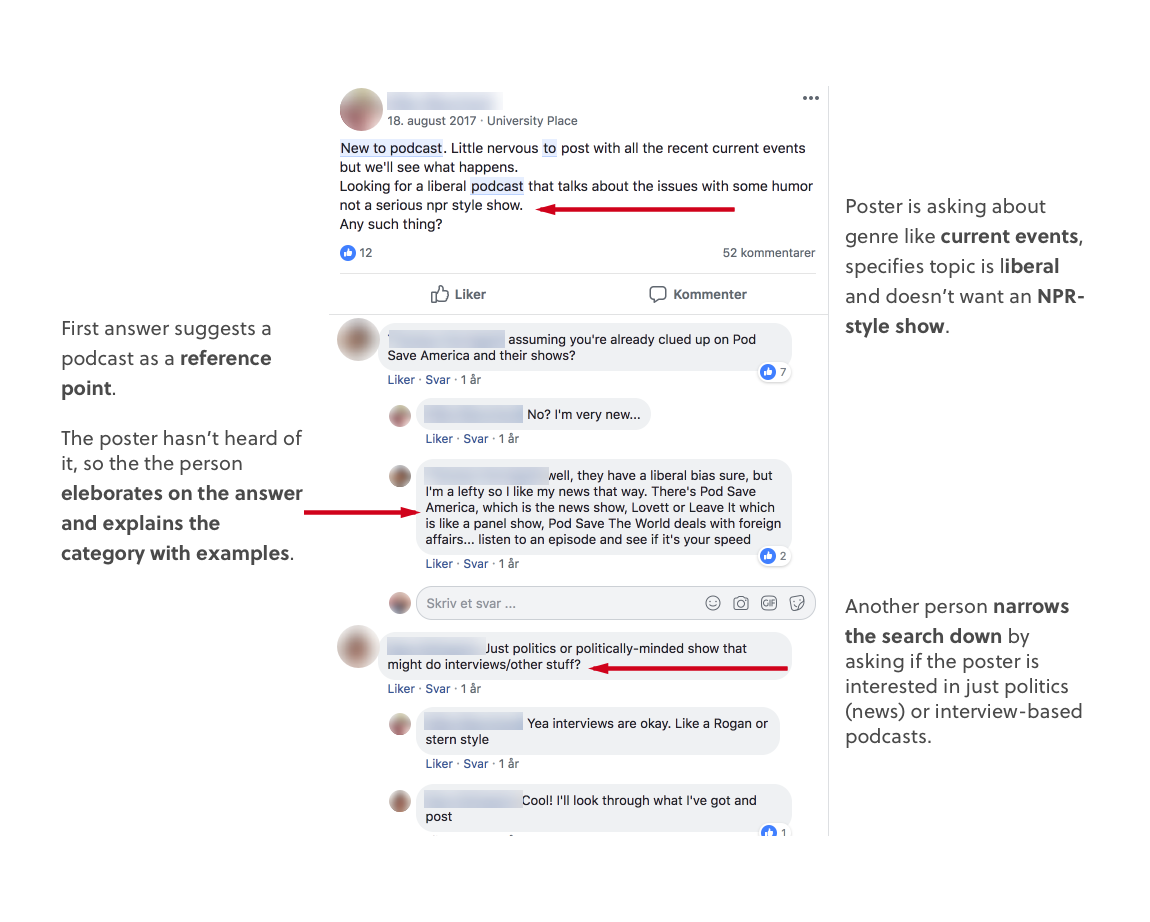
I jotted down a few different scenarios keeping in mind what a hardened podcast listener want to get out of a question like “Find me a podcast” vs. a new listener who isn’t so sure podcasts are for them. Since the bot will know it’s your first time chatting with it, asking the user if they already listen to podcasts is a good place to start.

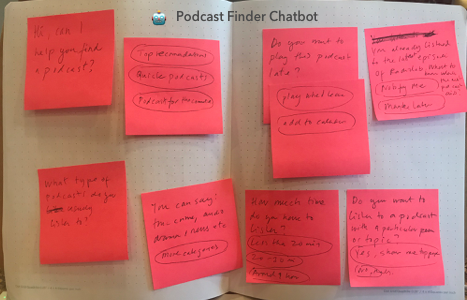
First Things Frist: Who’s the Bot?
The Podcast Finder bot helps you discover the podcasts you want to listen to, and plan when you want to listen. The bot is helpful, never disparaging about any type of content, friendly, and doesn’t use slang or rude language.
The Podcast Finder Bot loves to recommend podcasts you may not have found otherwise. It empathizes about the long commute or time spent doing chores alone.
The writing style is friendly, familiar, and easy to understand. The bot uses family-friendly, kid-safe emojis.
The purpose of the Podcast Finder Bot is to help people plan for their day, their commute, and chores by recommending podcasts they can listen to while doing a secondary activity. The goal is to delight the user with new content they wouldn’t have found on their own by showing trailers and providing great search results for genres, topics, and people.
Task Flow
From the interviews and chat sketches, I mapped out the key features like having trailers for content, searching by genres and topics, and getting better recommendations based on what you already listen to. The task flow itself may not be directly displayed to the user talking to the chatbot, but the conversation will guide them.

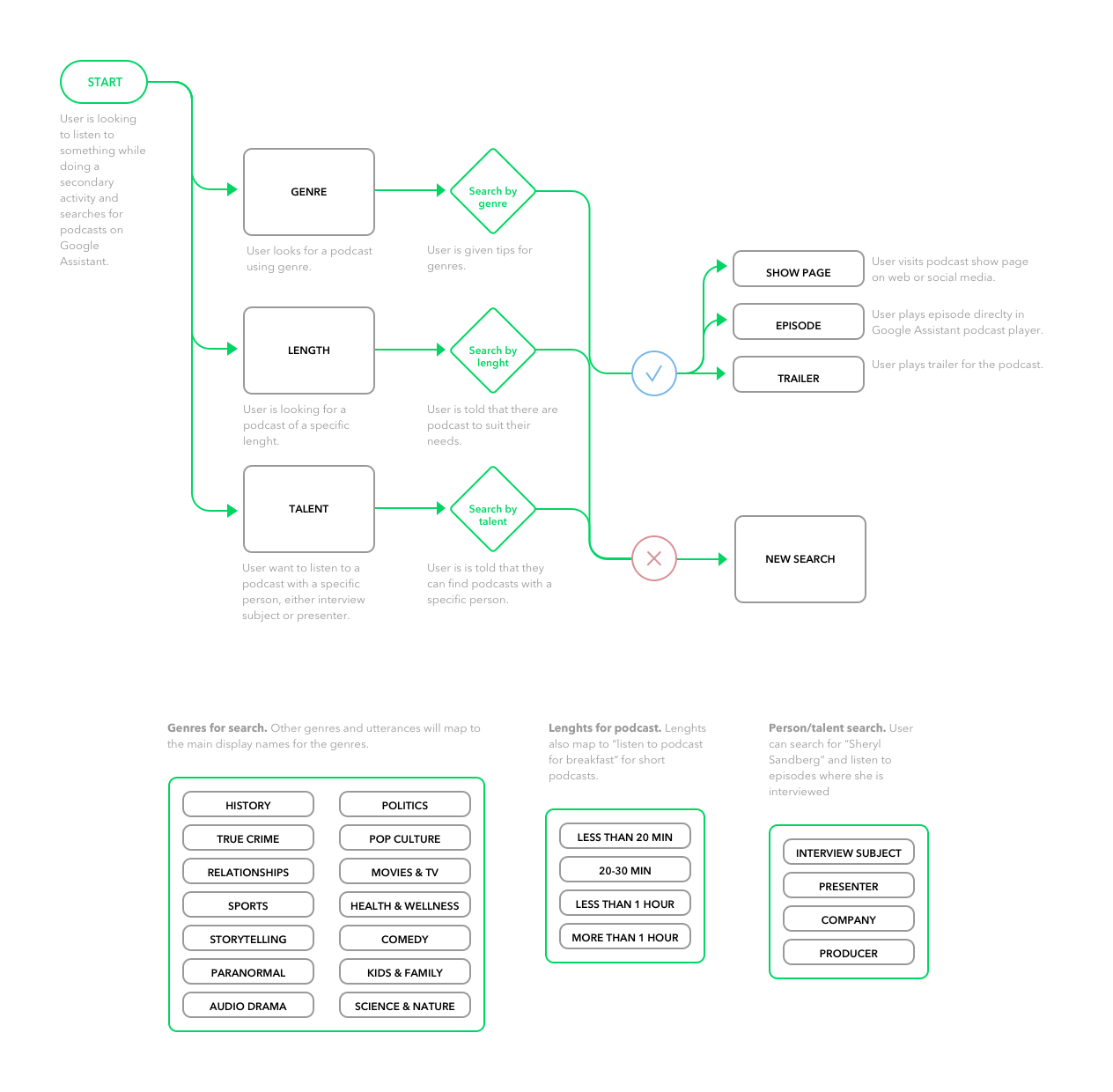
The Result
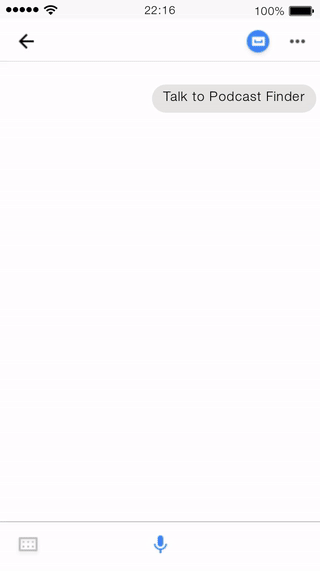
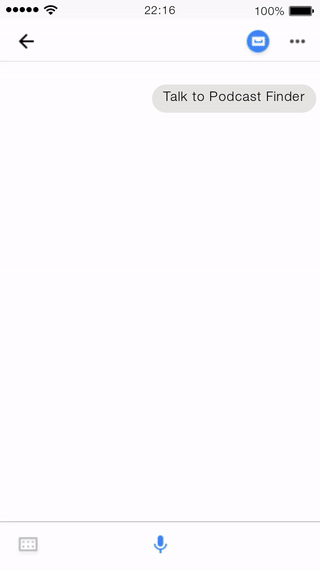
1. Describe the bot’s purpose.
“I’m your friendly Podcast Finder bot.”
2. Provide an action item for the user.
“Do you already listen to podcasts?”
3. Tell the user how they can use the bot for a task.
“Let’s figure out some recommendations for you.”
The most basic goal is to inform the user of the capabilities and expected user experience for the Podcast Finder chatbot. That way they know what to expect from it in the future.

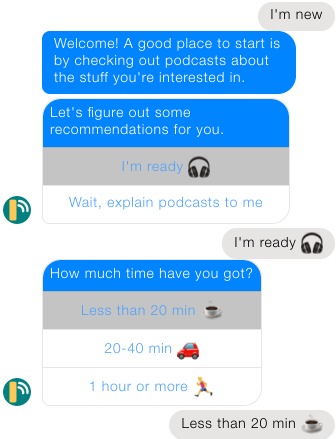
After onboarding, the chatbot needs to lead the conversation and bring users back to the flow when they leave it with new recommendations and ways to engage.

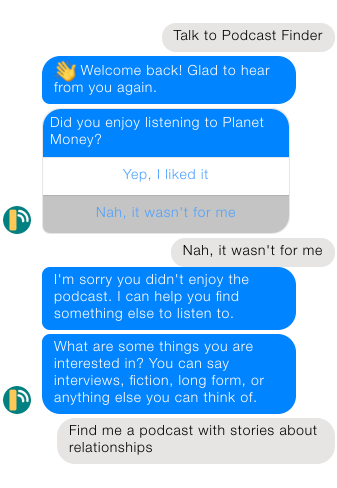
Sure, it’s a bot, but make sure you’re not a conversation hog. Breaking longer sentences and questions into parts, making sure to engage the user in proper turn-taking, makes for a more natural and pleasant experience.

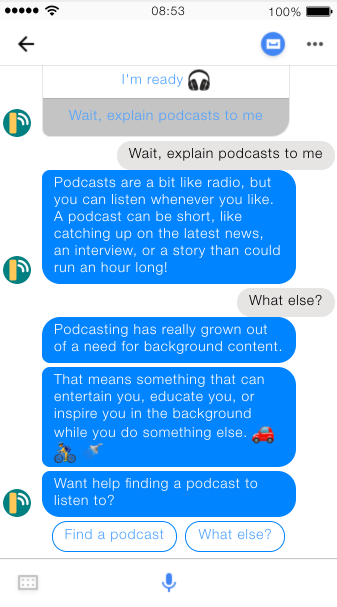
So, you made a recommendation for a podcast, but the conversation doesn’t have to end right there. To make sure the user doesn’t run out of options, provide them with a few different paths. For instance, the path to “Listen later” lets the user set up a reminder to play a podcast, but doesn’t put a stop to the chat. The user is still free to explore other podcasts or rest assured that they will listen to something they picked out later.

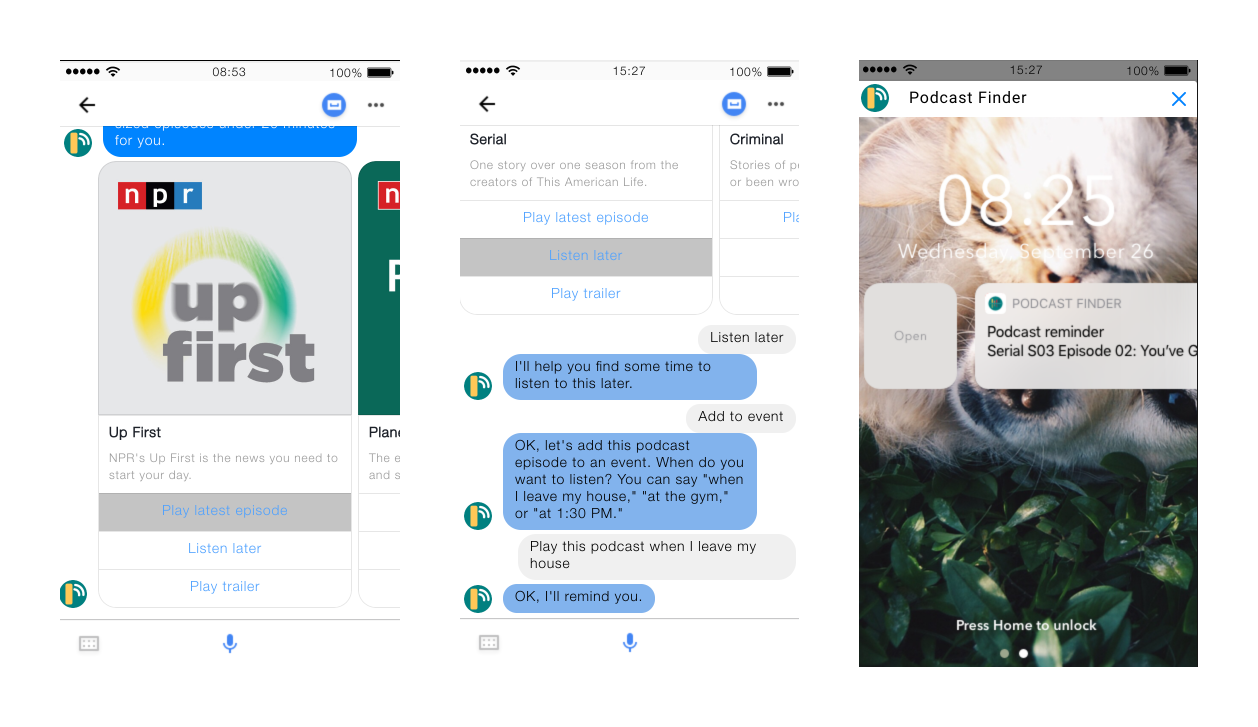
Conclusion
Writing for Conversational UI was a lot harder than I had imagined. After writing out the paths, I went over them with scissors and cut, cut, cut until only the essential was left.
One thing that helped me to think about how to have a natural conversation was to read countless forums and chat with real people and record the conversation to understand the exchanges.
I would have loved to create a working bot, and I did some testing by building out the intents, utterances, entities and even did some basic testing in Google’s Dialogflow, but the API integration was too tricky to get to work.
Most rewarding of all were the chuckles I heard when people interacted with my prototype.

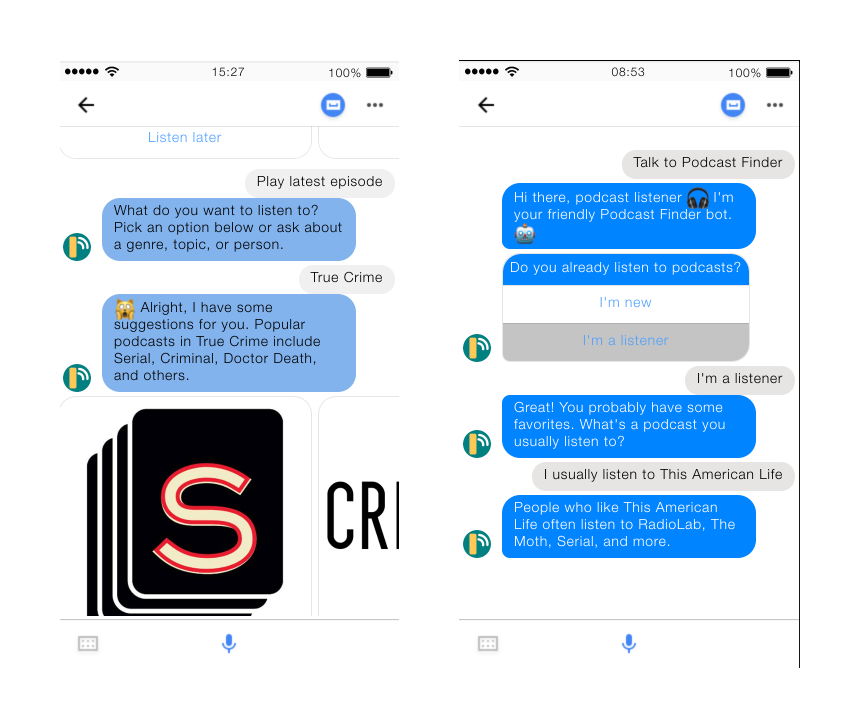
Some of my key takeaways:
Nobody expects a conversation from yesterday to be around today. If you chat with your user about a Podcast recommendation, they will not go back to that same conversation the next time they are looking for a podcast. It’s essential that at chatbot does not just replay the same conversation again, but is aware that the two of you chatted, like a real friend.
Space is limited, both in messages and in quick replies. If we overwhelm the user with words, we can be pretty sure they will miss some of them and come away feeling slow and frustrated.
